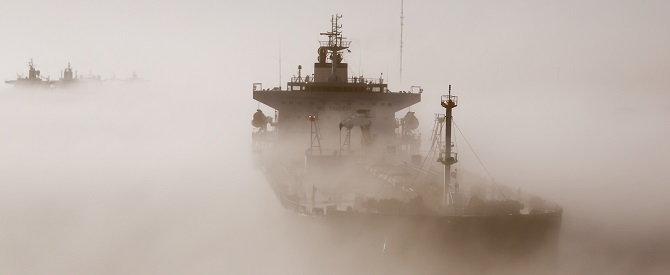
Editor’s note: Coastal and river borne transportation are important means of transporting base oils from refineries along the United States Gulf Coast, especially for lubricant blenders in the South, Midwest and in Eastern states with proximity to rivers such as the Mississippi and the Ohio. Barges offer an efficient means of delivery but are also vulnerable to weather disruptions. This article, the first in a three-part series, is about one of those disruptors: fog.
Hurricanes justifiably cause much consternation for Gulf Coast base oil refiners and their customers, but fog is a bigger disruptor, settling in more frequently and fouling supply chains for up to weeks at a time.
To understand the impact it can have, consider what unfolded on the Houston ship channel in February 2019. Heavy fog closed down traffic is for two and a half weeks that month, disrupting feedstock deliveries to refineries and petrochemical plants and blocking scores of tugboats and barges from delivering base oils. Industry sources estimate that the disruption cost base oil and lubricant companies millions of dollars.
“The impact [of fog] is felt by producers and customers,” said Jason Hoff, base oil manager for Motiva Enterprises.
The industry also uses other modes for transporting base oils, but barges are the most economical way to get base oil to customers – at least to those that are close enough to navigable rivers. Motiva’s Hoff said a normal barge holds 10,000 barrels of base oil, but that some can hold 15,000 to 20,000 barrels. It would require 216 rail cars plus six locomotives to move 15,000 barrels by train or 1,050 large semi tractor-trailers, according to the Waterways Council Inc. The trade group also reported that barges can move a ton of cargo 647 metric ton-miles per gallon of fuel, compared to 477 ton-miles by rail and 145 ton-miles miles by truck.
Barges travel much slower, of course. Hoff pointed out, transportation time on barge can be nearly ten times as long versus truck. He said barges traveling from the Gulf Coast to distant reaches of the Mississippi or Ohio rivers can take 20 days to a month to arrive, while rail cars up to two weeks and a truck anywhere between three to four days.
Still, the vast amounts that can be carried by barges make them a popular choice for moving base oils. Industry sources said a significant portion of base oils consumed in the South and Midwest are delivered this way, though estimates are difficult to obtain
It’s no wonder then that fog season is feared. “A lot of sleep is lost at night,” said one industry insider of fog. “Even with advanced weather technology sometimes it [fog] still brings transportation to a halt and that causes major issues with deliveries.” Peak fog season stretches from December or January to March of April and can cause many headaches during that period.
An especially dense fog is most common during February, according to the National Weather Service. Mark Fuchs, a service hydrologist with the NWS in St. Louis, said waterways used as major shipping routes produce advection fog, caused when warm, moist air moves over cooler, dense air. Being thicker, it makes visibility even more difficult.
“Imagine putting a wet beach towel over every window of your car at night and trying to drive 100 miles per hour, using only your GPS,” explained Capt. Michael Bopp, president of the Crescent River Port Pilots’ Association of steering a barge through fog. “It’s sort of like that, but the risks are much higher.”
Several times each season, the U.S. Coast Guard must issue vessel safety advisories during the fog season, where all mariners are expected to use extra caution in areas of reduced visibility. The nine-point advisories don’t require river traffic to halt, but barges must reduce speed and maintain proper lookouts. These advisories are meant, the Coast Guard said, to reduce fog-related accidents and more generally to ensure safe movement on waterways. In 2019, nearly 20 fog advisories were issued by the Coast Guard along the Mississippi River.
The length of delays that these incidents cause to individual cargoes can vary greatly – from as short as a couple hours to weeks – as can the amount of time lost in a season. In late February New Orleans’ Crescent City Pilot Association reported that only a few days had been lost during 2020, though the organization noted that the season wasn’t over. A mild winter helped keep barges moving along the mighty Mississippi and other river ways, including the Ohio, sources said.
Base oil suppliers as well as lubricant blenders agreed that fog can be a formidable disruption. In some years it may only halt shipping a few days, but when it hits hard the costs can be enormous. The 17-day closure of the Houston Shipping Channel in 2019 caused more than $1 billion dollar in losses for all industries, according to estimates. In 2015, fog shut the shipping channel for just shy of a month, 28 days total.
Those years may be outliers, but any company relying on barges to deliver raw materials will eventually be impacted. “Fog is not a discriminator,” Hoff concluded. “It hits everyone.”

Ships move through thick fog on the Mississippi River.